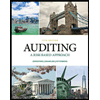
Essentials of Corporate Finance
8th Edition
ISBN: 9780078034756
Author: Stephen A. Ross, Randolph W. Westerfield, Bradford D. Jordan
Publisher: MCGRAW-HILL HIGHER EDUCATION
expand_more
expand_more
format_list_bulleted
Concept explainers
Question
Chapter 18.6, Problem 18.6ACQ
Summary Introduction
To determine: The political risk.
Introduction:
The companies with important foreign operations are often termed as the international corporations or the multinational companies. The multinational companies have to consider various financial factors that do not affect the domestic companies. The various factors are the rates of interest that vary from one country to another, foreign exchange rate, foreign tax rate, typical accounting methods, and the foreign government intervention.
Expert Solution & Answer
Want to see the full answer?
Check out a sample textbook solution
Students have asked these similar questions
Need answer.
Solve plz now
Precious metal qn solve .
Chapter 18 Solutions
Essentials of Corporate Finance
Ch. 18.1 - Prob. 18.1ACQCh. 18.1 - Prob. 18.1BCQCh. 18.2 - What is triangle arbitrage?Ch. 18.2 - Prob. 18.2BCQCh. 18.2 - Prob. 18.2CCQCh. 18.3 - Prob. 18.3ACQCh. 18.3 - Prob. 18.3BCQCh. 18.4 - Prob. 18.4ACQCh. 18.4 - Prob. 18.4BCQCh. 18.5 - Prob. 18.5ACQ
Ch. 18.5 - Prob. 18.5BCQCh. 18.6 - Prob. 18.6ACQCh. 18.6 - Prob. 18.6BCQCh. 18 - Prob. 18.1CCh. 18 - Prob. 18.2CCh. 18 - Prob. 18.3CCh. 18 - Prob. 18.4CCh. 18 - Prob. 18.6CCh. 18 - Prob. 1CTCRCh. 18 - Purchasing Power Parity. Suppose the rate of...Ch. 18 - Exchange Rates. The exchange rate for the...Ch. 18 - Prob. 4CTCRCh. 18 - Prob. 5CTCRCh. 18 - Prob. 6CTCRCh. 18 - Prob. 7CTCRCh. 18 - Prob. 8CTCRCh. 18 - Exchange Rate Movements. Some countries encourage...Ch. 18 - Prob. 10CTCRCh. 18 - Prob. 1QPCh. 18 - Prob. 2QPCh. 18 - Prob. 3QPCh. 18 - Prob. 4QPCh. 18 - Prob. 5QPCh. 18 - Prob. 6QPCh. 18 - Prob. 7QPCh. 18 - Prob. 8QPCh. 18 - Prob. 9QPCh. 18 - Prob. 10QPCh. 18 - Prob. 11QPCh. 18 - Prob. 12QPCh. 18 - Prob. 13QPCh. 18 - Prob. 14QPCh. 18 - Prob. 15QPCh. 18 - Prob. 16QPCh. 18 - SS Air Goes International Mark Sexton and Todd...Ch. 18 - SS Air Goes International Mark Sexton and Todd...Ch. 18 - SS Air Goes International Mark Sexton and Todd...Ch. 18 - SS Air Goes International Mark Sexton and Todd...Ch. 18 - SS Air Goes International Mark Sexton and Todd...
Knowledge Booster
Learn more about
Need a deep-dive on the concept behind this application? Look no further. Learn more about this topic, finance and related others by exploring similar questions and additional content below.Similar questions
arrow_back_ios
SEE MORE QUESTIONS
arrow_forward_ios
Recommended textbooks for you
 Cornerstones of Financial AccountingAccountingISBN:9781337690881Author:Jay Rich, Jeff JonesPublisher:Cengage Learning
Cornerstones of Financial AccountingAccountingISBN:9781337690881Author:Jay Rich, Jeff JonesPublisher:Cengage Learning EBK CONTEMPORARY FINANCIAL MANAGEMENTFinanceISBN:9781337514835Author:MOYERPublisher:CENGAGE LEARNING - CONSIGNMENTBusiness Its Legal Ethical & Global EnvironmentAccountingISBN:9781305224414Author:JENNINGSPublisher:Cengage
EBK CONTEMPORARY FINANCIAL MANAGEMENTFinanceISBN:9781337514835Author:MOYERPublisher:CENGAGE LEARNING - CONSIGNMENTBusiness Its Legal Ethical & Global EnvironmentAccountingISBN:9781305224414Author:JENNINGSPublisher:Cengage Auditing: A Risk Based-Approach (MindTap Course L...AccountingISBN:9781337619455Author:Karla M Johnstone, Audrey A. Gramling, Larry E. RittenbergPublisher:Cengage LearningBusiness/Professional Ethics Directors/Executives...AccountingISBN:9781337485913Author:BROOKSPublisher:Cengage
Auditing: A Risk Based-Approach (MindTap Course L...AccountingISBN:9781337619455Author:Karla M Johnstone, Audrey A. Gramling, Larry E. RittenbergPublisher:Cengage LearningBusiness/Professional Ethics Directors/Executives...AccountingISBN:9781337485913Author:BROOKSPublisher:Cengage

Cornerstones of Financial Accounting
Accounting
ISBN:9781337690881
Author:Jay Rich, Jeff Jones
Publisher:Cengage Learning

EBK CONTEMPORARY FINANCIAL MANAGEMENT
Finance
ISBN:9781337514835
Author:MOYER
Publisher:CENGAGE LEARNING - CONSIGNMENT

Business Its Legal Ethical & Global Environment
Accounting
ISBN:9781305224414
Author:JENNINGS
Publisher:Cengage

Auditing: A Risk Based-Approach (MindTap Course L...
Accounting
ISBN:9781337619455
Author:Karla M Johnstone, Audrey A. Gramling, Larry E. Rittenberg
Publisher:Cengage Learning


Business/Professional Ethics Directors/Executives...
Accounting
ISBN:9781337485913
Author:BROOKS
Publisher:Cengage